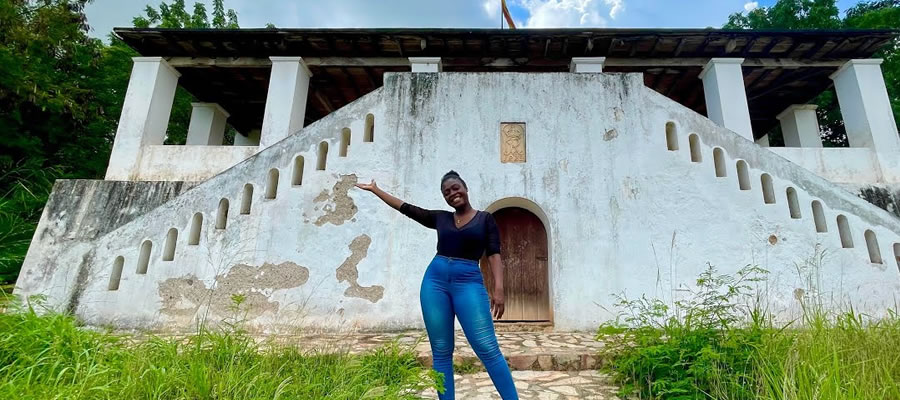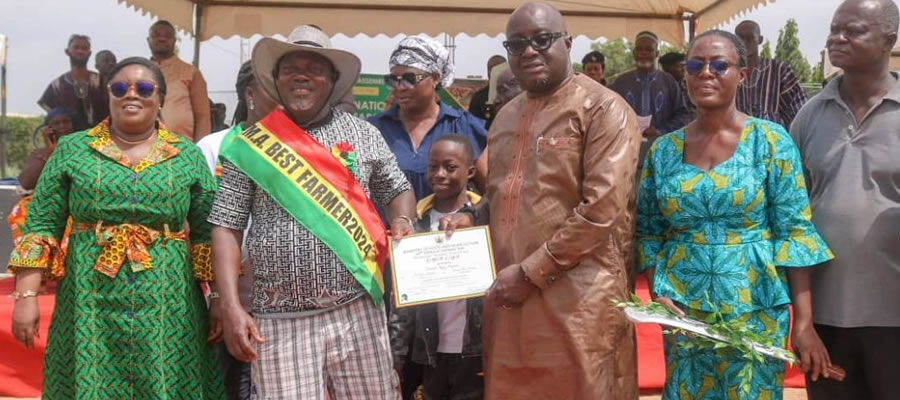

Population Size and Growth
The 2010 National Population and Housing Census put the Municipal Assembly’s population at 147,742 with an inter-censal growth rate of about 2.5%. The projected population for the planned period is estimated at 217,457. The growth of the population is mainly due to the influence of migration inflows. The estimated population by the Municipal Planning Coordinating Unit (MPCU) is about 208,943 people. The Municipality therefore finds the projected figure more reliable for planning purposes.
The 2010 population figure yields a density of 1,214 persons per sq km much higher than the national density of 79.3 and the regional density of 895.5 persons per sq. km. This indicates a great pressure of population on land and resources or what the land can generate. The sex ratio according is 97.6 percent while the population density stands at 1,725 persons /square km.
The structure of the population has about 51% males and 49% females with an average household size of 3.9 per household. Children constitute the largest proportion of the household members. There are about 52 settlements in the Municipality with Abokobi, a well-known Presbyterian community as the Municipal capital. The population is concentrated mainly along the urban and peri-urban areas of the Municipality particularly along the border with AMA to the south. These include Dome, Taifa, Kwabenya and Haatso among others.
The Municipality has a very good proportion of the working age group that is 15-64years. The dependency ratio is a low 52 percent meaning less pressure on persons who take care of their dependants. The Economically active population is 70 percent with 92.1 percent employed and 7.9 percent unemployed. The remaining 30 percent who are economically inactive are homemakers, students, too old or young to work, pensioners or disabled.
Age-Sex Structure (population Pyramid)
Figure 1.6 indicates that, the Municipal has a youthful population with the age cohorts 0 - 4, 5 - 9, 10 - 14, and 25 -29 having the majority of the population. The population pyramid for the Ga East Municipal reflects a typical feature in developing countries population with a broad based youthful population and a narrow apex suggesting fewer aged persons. The increase of the aged population is an indicative of good health care in the municipality. The rich experience of the aged should be tapped for development.
With the aged population, it is important to provide infrastructure facilities to support them. As women spend more time schooling, the chances of entering into early marriages reduce, which then reduces the fertility rates. The Municipality together with other collaborators such as the GSS and NGOs should get funds to find out what the pull and push factors were in the Municipality. This will enable the Municipality to check the emerging issues related to streetism and slum development
Labour Force and Dependency Ratio
About 63.6% of the population of the Ga East Municipality falls within the economically active age group. Dependency ratio shows the relative predominance of persons in dependant ages (persons less than 15 and those above 65) and those in the productive ages (i.e. 15-64 years). The 0-14 year group is the children population, 15-64 constitute the working population and 65+ forms the aged group. The current dependency ratio is estimated to be 1:0.52 or 52%, which means that for every 100 people aged 15-65 years, there are approximately 52 people depending on them for survival. In other words, each person within the working age group has less than one additional person to cater for. Dependency ratio in the Municipality is less in urban localities (52.0) than in rural localities of (53.3).
Fertility
Fertility analysis is important tool for socioeconomic planning and policy implementation. The 2010 population and housing censuses provides that total fertility rate which is the number of live births among 1,000 women exposed throughout their child bearing year in Ga East is 2.8. The general fertility rate which is the number of births in a given year divided by the mid-year female population of the 15-49 age group is 84.1. The Crude Birth Rate (CBR) on the other hand is 25.1. Compared with the other districts in the, the municipality recorded the third highest Crude Deaths Rate of 3.4.
Rural-Urban Population
The urban/peri-urban population constitutes 82% of the Municipality’s total population with the remaining 12% residing in the rural portion towards the Akwapim Hills. The Municipality can therefore be described as urban. Indeed, the level of urbanization is above the national average of 43.4%. It is however important to note that the urban population resides in about 65% of the total land area of the district. This indicates a densely populated urban area with its associated pressure on social infrastructure and land. Land litigation, encroachment on the few open spaces; overcrowding and construction of illegal structures are some of the development challenges the Assembly has to manage.
The hitherto sparsely populated rural area is also gradually opening up with the location of the Municipal capital at Abokobi and the construction of the Pantang to Ayimensah portion of the Accra-Aburi trunk road. Effective development control, upgrading and provision of the requisite social amenities are therefore some of the development issues that need to be addressed.
Household Characteristics
The 2010 census report defines a household as “a person or group of persons who live together in the same house or compound, share same house keeping arrangement and are catered for as one unit”. The average household size in the municipality is estimated at 3.9. The total number of households in the municipality is estimated at 144,863 out of which 49.3 percent are male and 50.7 percent are females. The 2010 population census reveals that the nuclear family system is dominant among the various households within the municipality.
Migration Pattern
Migration is one of the components of population dynamics. According the 2010 cencus about 72 percent of the total population of the Municipality are migrants. A higher proportion of migrants from the Eastern Region (22.0%) have stayed in the Municipality for more than ten years. As a result of the worsening socio-economic situation in the rural areas and the municipality’s proximity to the Accra Metropolitan Assembly, more and more people migrate to the main urban and peri-urban areas of the municipality. These include Haatso, Dome, Taifa and Agbogba with the hope of securing better paid jobs and a higher standard of living. It is however worrying to note that majority of these migrants is in their youthful age and has no employable skills. Consequently, they are compelled to engage in jobs like head portage (kaya yoo), truck pushing and street hawking. A survey conducted by the MPCU indicated that most of them come from the northern sector of the country, specifically, Northern region, Upper East and West regions which are the top three poor regions in the country.
Settlement Pattern
The Ga East Municipal Assembly has about 52 settlements with about 90% of the population living in the urban areas. The remaining 10% occupies the rural areas. The Municipal capital Abokobi is approximately 29 kilometers from the countries capital city Accra. The Municipality’s large towns include Haatso, Dome, Taifa and Kwabanya. The Municipality has other small towns which are linked to the trunk road via feeder roads. Despite Dome being the largest community, Kwabenya and Haatso is the highest ranked community with most basic facilities and services. It functions as a commercial center because of its threshold population that can support almost all economic.
Spatial Analysis
Providing a well-designed physical development planning scheme are a desirable built-up environment where essential facilities and services exist is a priority for the Ga East Municipal Assembly. However, ownership of lands as well as land litigations serves as a major setback to such an important priority in the Municipality. Below is the scalogram depicts the various functions that exist in the various communities.
In ensuring that the spatial dimension of the Municipality is considered into the plan, analysis was conducted using the scalogram. Scalogram is a tool. This tool is a matrix presentation of the functional structure of settlements by giving an impression about the functions settlements perform in a given area thereby helping in future project allocation for communities. The scalogram was used to determine the centrality and spatial linkages between the settlements and to examine the nature and distribution of all types of facilities available in the Municipality.
The distribution of services is presented in In total, 20 out of the 438 settlements with populations above 1500 were considered together with 40functions. The most populous was Dome with population 59,960 followed by Haatso with a population of 52928. The least was Adenkrebi with an estimated population 492.With the exception of Dome, Haatso, Taifa, Agbogba and other communities such as Kwabenya Papao, Parakuo Estate Ashongman and Ashongman all the other communities had population figures below 5,000. This implies that a high proportion of the population in the Municipality live in urban areas; thus, having a high rural-urban split of 44:56 as against 63:37 for the Nation.
The categorisation of the hierarchy of settlements was based on the centrality index of each settlement, and not merely the number of functions or percentage functions of the settlement. The centrality index or total weighted centrality of a settlement is the summation of the weighted centrality of the services in each settlement. A cut off point was determined to depict the order of settlements. The first order settlement, also known as level one, must have a centrality index or total centrality above 400, level 2 and 3 settlements must have a score of 399 to 300and 299 to200 respectively. Level 4 settlements must have score of199 and 100 and level 5 settlements below 100.
Haatso and Kwabenya communities, with a population of 14,360 and 10438 respectively emerged as the only level 1 settlement. They both have 24 and 23 out of the 40 functions considered. Taifa, Atomic and Abokobi settlement qualified to be a second order or level 2. Dome, Agbogba Ashongman Estate, Old Ashongman and Christian village were found to be third order. The fourth order settlements were Paraku Estate, Boi, Kissieman, Akporman, Abloradjei, Sesemi, Adenkrebi and Ajako.
An analysis of the spatial economy reveals that the provision of services in the Municipality is inadequate and their distribution too skewed in favour of the urban areas like Dome, Taifa Haatso and Kwabenya. Again, there is an absence of important facilities such as health facilities in most rural communities in the municipality. The municipality does not have any tertiary educational facility to serve its ever-increasing population.
On the flip side, most of the top twenty (20) communities in the district have access to water facilities, basic education facilities, telephone services, fuel stations, hotel facilities and electricity.
The functional region was drawn using the high access zones with the optimum accessibility. This includes communities like Haatso, Kwabenya Dome, Taifa, Ashongman Estate, Papao and Christian Village.
Date Created : 11/17/2017 8:59:25 AM













 facebook
facebook
 twitter
twitter
 Youtube
Youtube
 +233 593 831 280
+233 593 831 280 0800 430 430
0800 430 430 GPS: GE-231-4383
GPS: GE-231-4383 info@ghanadistricts.com
info@ghanadistricts.com Box GP1044, Accra, Ghana
Box GP1044, Accra, Ghana